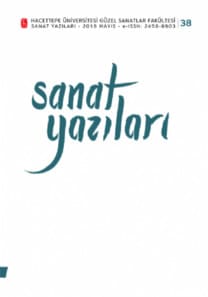SEYİRCİ - KATILIMCI ARASINDA: FATMA BUCAK'IN NE MUTLU GELEN SANA YAPITI ÜZERİNDEN DEĞİŞEN SEYİR BİÇİMLERİNE DAİR BİR İNCELEME
Bu yazı Fatma Bucak'ın "Blessed are who you come / Ne mutlu gelen sana" işinin tetiklediği sorular vasıtasıyla günümüz sanatında yapıt ve seyirci arasındaki geleneksel ilişkinin dönüşümüne yeniden bakar. Bucak'ın yapıtı seyirci - gözlemci - figüran - katılımcı rollerinin sınırlarını belirsizleştirirken sanatçı, seyirci ve yapıt arasındaki dengenin değişen koşullarına da vurgu yapar ve alışık olduğumuz seyir düzenine dair ön kabullerimizi ortaya serer. Bu metnin amacı da Bucak'ın performansı üzerinden seyirci ile sanatçı arasındaki ilişkiyi sorunsallaştıran günümüzün katılımcı, diyalojik, ilişkisel estetiğinin tanımladığı yeni seyirci modellerini tartışmaya açmaktır.
BETWEEN SPECTATOR AND PARTICIPANT: AN ANALYSIS OF THE CHANGING FORMS OF SPECTATORSHIP THROUGH FATMA BUCAK'S WORK BLESSED ARE WHO YOU COME
This text reviews the shift in the conventional relation between artwork and its audience through the questions triggered by Fatma Bucak's work "Blessed are who you come / Ne mutlu gelen sana". While blurring the boundaries between audience-observer- bit playerparticipant, Bucak's work emphasises the changing conditions of the balance between artist, audience and the art work and reveals our presuppositions about the order of spectacle. Thus, the aim of this text is to discuss new models of audience defined by the contemporary participatory, dialogical an relational aesthetics that question the relation between audience and the artist through Bucak's performance.
___
Badiou, Allain. (2013). Çağdaş Sanat Üzerine On Beş Tez. Eskop: E-Dergi, Sanat Tarihi. Erişim: 02.2015, http://www.e-skop.com/skopbulten/cagdas-sanat-uzerine-on-bes-tez/1376.Bakçay, E., Özden, F. B. (2013). Çağdaş Sanattan Radikal Siyasete, Estetik-Politik Eylem. Eskop: E-Dergi, Sanat Tarihi. Erişim: 12.02. 2015, http://www.e-skop.com/skopbulten/cag- das-sanattan-radikal-siyasete-estetik-politik-eylem/1384.
Belting, Hans. (2011). Florence and Baghdad: Renaissance art and Arab science. Cambrid- ge, Mass.: Belknap Press of Harvard University Press.
Bishop, Claire. (2012). Artificial hells: Participatory art and the politics of spectatorship. London: Verso Books.
Bourriaud, Nicholas. (2002). Relational aesthetics. Dijon: Les Presses du re?el.
Crary, Jonathan. (2004). Gözlemcinin Teknikleri: On Dokuzuncu Yüzyılda Görme ve Moder- nit. İstanbul: Metis Yayınları.
Deutsche, Rosalyn. (1996). Evictions: Art and spatial politics. Chicago, Ill.: Graham Founda- tion for Advanced Studies in the Fine Arts.
Deutsche, Rosalyn. (1999). The Question of Public Space, American Photography Institu- te National Graduate Seminar Proceedings. New York: The Institute. Erişim: 12.02.2015, https://iwalewapublicspace.files.wordpress.com/2012/02/rosalyn-deutsche-_-the-ques- tion-of-_public-space_.pdf .
Doherty, Brian. (2000). Inside the white cube: The ideology of the gallery space. Berkeley: University of California Press.
Kester, Grant. (2004). Conversation pieces: Community and Communication In Modern Art. Berkeley: University of California Press.
Ranciere, Jacques. (2008). Art & Research : Aesthetic Separation, Aesthetic Community by Jacques Rancière, 2, 1. Erişim: 12.02. 2015, http://www.artandresearch.org.uk/v2n1/ ranciere.html.
Temür, Başak Doğa. (2013). Sergi Koordinatörü. Fatma Bucak: Düşüşe Dair Bir Hikaye Daha = Yet another story about the fall: Arter.
Yüksel, Ayşegül. (1990). Antik Yunan Tiyatrosunda Komedyanın Evreleri . Ankara Üniversi- tesi Dil ve Tarih-Coğrafya Fakültesi Dergisi, XXXIII,1-2, s. 557-569.
- ISSN: 2458-8903
- Yayın Aralığı: Yılda 2 Sayı
- Başlangıç: 2001
- Yayıncı: -
Sayıdaki Diğer Makaleler
PIETER BRUEGEL'İN RESMİNDE TEMATİK BİR İLİŞKİ OLARAK İKARUS'UN DÜŞÜŞÜ
CEPHENİN YAPIDAN, MEKÂNDAN VE ÇEVREDEN KOPUŞU
SANATTA METİNLERARASILIK: 20. YÜZYILDAN BUGÜNE
LIBERATE TATE X TATE LIBERATE TATE VE BP & TATE ORTAKLIĞINA KARŞI PERFORMATİF EYLEMLERİ
TOLSTOY'UN SANAT FİKRİ RUS YAZAR TOLSTOY'UN SANAT NEDİR? İSİMLİ ESERİ ÜZERİNE İNCELEME
KÜLTÜR ENDÜSTRİSİ İÇİNDE SERMAYE İLE SANATIN PATOLOJİK İLİŞKİSİ
TASARIM DÜNYAYI KURTARIR MI? ÇEVRE-DOSTU ÇANTA TASARIMI ÇALIŞTAYI ÜZERİNE DEĞERLENDİRMELER
